E.G. Lewis's Blog, page 3
June 27, 2012
DINING AT CAESAR'S PALACE

Hello my Friend and Welcome.
The picture above was taken at Caesar’s Palace alright, just not the one on the Palatine Hill in Rome. Admittedly the complex they’ve built in Las Vegas is pretty impressive… now, but let’s see what it looks like in 2,000 years.
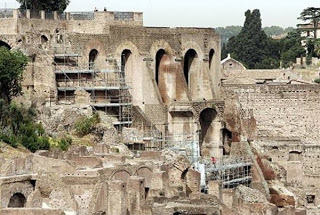 Extrior of the REAL Caesar's PalaceVISITING THE PASTA recent archaeological dig on the Palatine, a hill where the luxurious palaces and villas of the Caesars and other affluent Roman citizens once stood, has uncovered a richly decorated cavern. The cavern in question lies beneath the palace of Augustus, Rome’s first Emperor. He lived from 63 BC to 14 AD and is mentioned in Luke 2:1with the famous words, “In those days a decree went out from Caesar Augustus that all the world should be enrolled.” I expect we’ve all heard that a time or two while attending Christmas services.
Extrior of the REAL Caesar's PalaceVISITING THE PASTA recent archaeological dig on the Palatine, a hill where the luxurious palaces and villas of the Caesars and other affluent Roman citizens once stood, has uncovered a richly decorated cavern. The cavern in question lies beneath the palace of Augustus, Rome’s first Emperor. He lived from 63 BC to 14 AD and is mentioned in Luke 2:1with the famous words, “In those days a decree went out from Caesar Augustus that all the world should be enrolled.” I expect we’ve all heard that a time or two while attending Christmas services.This chamber lies roughly 50 feet beneath the surface. While there have been rumors that it is the Lupercale, the room where Romulus and Remus were nursed and the Romans held annual celebrations in honor of the legendary founders of Rome, most people believe it to be a private dining room. The 125 sq. ft. grotto is circular in design and adequate to comfortably house a triclinium, three Roman dining couches arrange in a U-shaped pattern.
 Boring in Through the CeilingNo one has entered the area since the cave is close to collapse. Instead, they drilled a hole through the ceiling and inserted a light and remote camera to see what was there. What they found was a ceiling encrusted with seashells, marble and mosaics. The walls have rectangular panels filled geometric shapes and flowers. The floor, which is not in good shape, also has elaborate mosaics.
Boring in Through the CeilingNo one has entered the area since the cave is close to collapse. Instead, they drilled a hole through the ceiling and inserted a light and remote camera to see what was there. What they found was a ceiling encrusted with seashells, marble and mosaics. The walls have rectangular panels filled geometric shapes and flowers. The floor, which is not in good shape, also has elaborate mosaics.
 Ceiling Decorations
Ceiling DecorationsCOOL DINING IN THE SUMMER’S HEATIt is well known that many Roman Emperors, including Nero and Caligula, had small dining rooms built into the natural hollows in the rock underneath their multi-storied palaces. If you’ve ever lived in home with a basement, you know that the temperature remains very comfortable even on the hottest of days. It’s not hard to imagine old Augustus slipping away on a hot night and descending a stairway to his private retreat where he could recline in comfort and dine on delicacies.
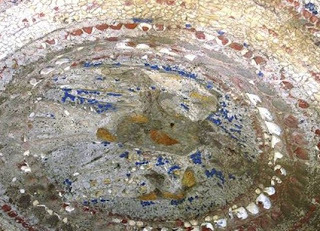 Remnants of the Mosaic FloorSo are we looking at the spot where the great emperor feasted with a small circle of friends on roasted peacock tongues seasoned with fermented fish sauce? We very well could be. One wall of the room displays a white eagle, the symbol of the Roman Empire during the reign of Augustus.Until next time, we wish you Peace and Blessings.If you reached this post via a link, click the HOME tab above to see other recent posts and visit our archives.
Remnants of the Mosaic FloorSo are we looking at the spot where the great emperor feasted with a small circle of friends on roasted peacock tongues seasoned with fermented fish sauce? We very well could be. One wall of the room displays a white eagle, the symbol of the Roman Empire during the reign of Augustus.Until next time, we wish you Peace and Blessings.If you reached this post via a link, click the HOME tab above to see other recent posts and visit our archives.
Published on June 27, 2012 01:00
June 25, 2012
COSMETICS IN THE FIRST CENTURY
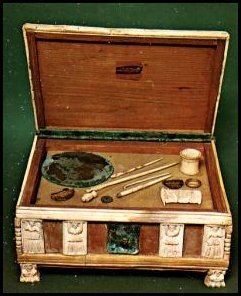 An Ancient Cosmetic CaseHello My Friend and Welcome.
An Ancient Cosmetic CaseHello My Friend and Welcome. “What has been is what will be, and what has been done is what will be done; and there is nothing new under the sun.” — Ecclesiastes 1:9
UNCHANGING HUMAN NATURE We can summarize the words of Solomon above in the simple conclusion that human nature has pretty much stayed the same over time. Men are men, and women are women. This is nowhere truer than in the realm of cosmetics and make-up. Cosmetics are, and were, used by women at all levels of society. Women in ancient times manicured their nails, tweezed superfluous hair, and outlined their eyes in colors including black, green, aqua, terracotta and charcoal.
Apparently humankind’s use of cosmetics dates to pre-historic times. Neolithic burials used red ochre pigments symbolically, either to represent a return to the earth or possibly as a form of ritual rebirth, in which the color symbolized blood and the Great Goddess. About twenty years ago an exhibit related to bathing and the use of beautifying compounds in the ancient Roman Empire was held in Paris. Called The Bath and The Mirror, one of its most interesting sections contained information about 144 different powders, unguents, and other cosmetic materials that had been excavated from various sites, many reconstituted and displayed in recovered glass or ceramic containers.
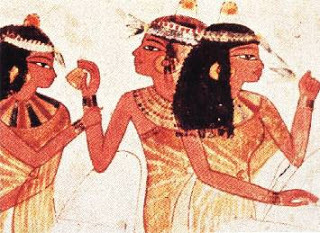
MABEL'S MASCARA Although the definition and standards of beauty differ from age to age and across cultures, the one constant is that women have always relied upon cosmetics to enhance their attractiveness. Even the derivations of the words themselves tell us interesting things. Take, for instance, the word mascara. The modern version, by the way, was invented by Maybelline’s founder, chemist T. L. Williams, for his sister’s use. His original recipe consisted of coal dust mixed with petroleum jelly. Since petroleum jelly was called Vaseline and his sister was named Mabel, he named the resulting concoction Mabelline.
And why is it called mascara? The Oxford English Dictionary says the word mascara probably came from a Catalan or Portuguese word meaning soot. How lovely. The word cosmetic, meanwhile, derives from the Greek kosmetike, meaning the art of dress and ornament.
JEWS AND GENTILES ALIKEWe know more about the cosmetics of Rome, Greece and Egypt than of the Jewish nation. This is not to say that women in Israel didn’t use make-up. They surely did, especially the upper classes. The area was thoroughly Hellenized and Romanized by the First Century. However, the Biblical prohibition against graven images meant that very few paintings, mosaics, frescoes or statues depicted the human form. A great deal of our knowledge of day-to-day life in the ancient world derives from the artistry preserved in places such as Pompeii, Herculaneum, the Pyramids, Temples, and other ruins. Though no such equivalent sources exist in the ancient Jewish world, we do have the Bible as a resource.
LOOKING TO THE BIBLE FOR CLUESPerfumes and fragrant spices were a precious commodity in antiquity, very much in demand, and at times exceeding even silver and gold in value. Therefore they were a luxury product, used mainly in the temples and in the homes of the nobles and the wealthy. The Judean kings kept them in treasure houses (2 Kings 20:13). And the Queen of Sheba brought Solomon, “camels laden with spices, gold in great quantity and precious stones.” (1 Kings 10:2). Over time the use of cosmetics became widespread among the lower classes of the population as well as among the wealthier. Despite this, make-up and cosmetics were not looked upon with favor in all quarters. When Samuel warns the Jews of the dangers of having kings, among his warnings he said, “He will take your daughters to be perfumers…” (1 Samuel 8:13)
CREATING THE SECRET FORMULAThe basic recipe for all cosmetics is pretty much the same — a fatty base, color, and a pleasant scent. To quote a character in my novel PROMISES, “They’re nothing but a pinch of product wrapped in a pound of promise.”
Just as T. L. Williams turned to Vaseline, the ancients relied upon such things as lanolin, a waxy, viscous fat most often derived from wool, tallow, beef fat, or lard, rendered pork fat. Before the development of synthetics in the latter half of the Twentieth Century, modern cosmetics used the same things. Lanolin had the disadvantage of having a distinctively sheepish smell. Both tallow and lard would keep for long periods of time without refrigeration if stored in air-tight containers. Exposed to oxygen in the air, they quickly grow rancid.
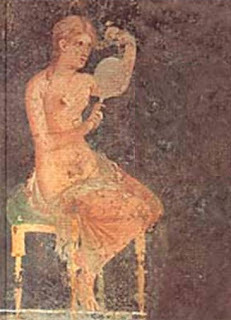
Once a base was chosen, color and scent were added. The colors used in kohl, or eye shadow, were mostly mineral based. Such materials were crushed to a fine powder and blended into the base. Stibium (antimony), Fulgio (lampblack- fine black soot), or Plumbum nigrum (black lead) where used to achieve a black paste. Greens came from copper oxide or Malachite, copper carbonate. Blues were derived from Azurite, hydrated, or weathered, copper ore. For reds they turned to iron oxide (rust). The earth pigment ochre was also used. A clay mineral, ochre is found in red, yellow, brown, purple or gold.
Ancient cosmeticians used a substance called Fuco (red algae) from the mulberry plant. Cinnabar, mercury sulfide, was also used for lipsticks. The consistency of the material could be moderated by the addition of waxes obtained from honey comb or palm leaves, giving it smooth, creamy texture.
FACIALS, EXFOLIANTS, AND EMOLLIENTS Facial masks were made from lentils, honey, barley, lupine (any of a number of leguminous plants which bear tall clusters of flowers), or fennel. Animal byproducts such as various internal organs or the placenta, marrow, genitalia, or gonads of birds, mice, crocodile, calves, cows, bull, mules and horses were added for vigor and skin tone.
For skin emollients they turned to vegetable oils, such as olive oil, almond oil, sesame oil and others. Fragrant resins and/or extracts of aromatic flowers were added to give them a sweet scent. Plant essences were obtained by chopping and pressing the leaves, roots, petals and flowers, then steeping them in hot oil. The essence of rose petals (Rhodium) was produced mainly in the town of Palestrina along the outskirts of Rome. Various species of lilies were also used. Myrtle and laurel (Mirtumand Susinum), Melinon extracted from Quince and Iasminum was extracted from jasmine. Aromatic resins exuded from certain trees — myrrh, frankincense, balm, balsam were collected as well.
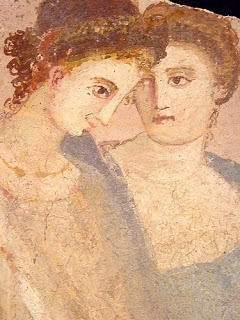
SCENTED OILS AND PERFUMESThese essences and scented oils could be added to a bath or applied to the body as perfume. Returning to the Jewish world and Jerusalem for a moment, we find references in the Talmud to perfume dealers who had shops in the market where scents and cosmetics for women were sold. Known as The Street of the Perfumers, this area still exists today as a narrow street in the marketplace in the Old City of Jerusalem.
The ancient Romans were as beauty-obsessed as any modern society. They studied plants and minerals for their cosmetic properties. Many Roman noble women owned cosmetic cases, which archaeologists have uncovered. These wooden beauty boxes contained the same items you would probably find if you emptied most modern women's purses…a variety of lipsticks and eye make-ups along with rouge, powders and a foundation for covering skin blemishes, freckles and other imperfections.
By the time of Christ there was a far flung and highly profitable industry devoted to gathering, preparing, packaging, and transporting the raw materials and specialized ingredients used in the manufacture of various cosmetics. Although called The Spice Route, the income derived from aromatic plants, balms, essences and the like rivaled that earned from the sale of medicinal and flavoring items. As the Early Church grew and spread throughout the Roman Empire, its focus on the life of the spirit, and rejection of earthly or bodily pleasures, led to a general decline, but not the elimination, of the use cosmetics and perfumes.
Until next time, we wish you Peace and Blessings.
If you reached this post via a link, click the HOME tab above to see other recent posts and visit our archives.
Published on June 25, 2012 01:00
June 22, 2012
JUNE CW BLOG CHAIN — PURSUING YOUR GOALS
 Climber at the top Mt. Hood.
Climber at the top Mt. Hood.
(Photo by Trin Yuthasastrakosol)
Hello My Friend and Welcome. Each year an estimated 8,000 to 10,000 people attempt to climb Mt. Hood, Oregon’s tallest peak. The operative word is attempt. Despite great intentions, only a very few actually make it to the top.Today we add our link to the Christian Writer’s Blog Chain. This month’s topic is pursuit and, as usual, we’ll examine it from an authorial viewpoint. Pursue is an active verb implying movement toward a goal. So the question becomes, what is your goal?
In her inaugural post, new blog chain member, Holly Michael, shared that when her son attended rookie camp with the New Orleans Saints his coach told the group, “Each of you are one out of three million kids that started playing football. There are 2,800 left. That means you are in the top 0.01%.” As someone whose mother once confessed she worried I’d never learn to walk because I kept tripping over my own feet, I stand in awe of such an achievement.
The novel as a distinct literary form, though predating the era of professional athletes, is also a relatively recent phenomena. The origins of this unique method of storytelling coalesced in the 18th Century. One of its early pioneers, Jonathan Swift, is credited with introducing allegorical elements and verisimilitude in his book, Gulliver’s Travels.
Although the novel continues to mutate and evolve, most of its essential components, along with a diversity of genres, were firmly in place by the close of the 19th Century. By then, Edgar Allen Poe had laid the groundwork for the macabre mystery novel, Jules Verne and H G Wells invented what used to be called science fiction, Wilkie Collins and Arthur Conan Doyle defined the first detective novels, Lew Wallace created the Biblical/Historical novel, and Mark Twain developed a uniquely American-styleof writing that melded humor with gritty realism.
Compared to our predecessors, we modern novelists have it pretty easy. The form is there and so are the plots. After all, how many times haven’t we been told, “There is no such thing as new plot?” Not only that, but we are blessed to live in the computer age. It boggles my mind to think of typing War and Peace page after page through various iterations. Nowadays it’s no problem to re-arrange sentences, paragraphs or even chapters. Highlight, Ctrl X, Crtl V and it's done! Change your main character’s name from Helen to Monique? No problem…Find and Replace All.
But easy or hard, the ultimate question remains Why bother to write in the first place? Whether you’re sitting down to a stone tablet with hammer and chisel or a comfortable desk in front of keyboard and monitor, you must have some goal in mind…you’re in pursuit of something. Perhaps you’re seeking personal fulfillment or a resolution to some inner conflict. You may feel led to share your unique viewpoint, experiences, truths and insights. Then again, maybe you just find filling a page with words arranged in a special order to be fun. I would never eschew the blending of art and commerce; a laborer is worthy of his wages.
In the final analysis, writing is a very personal endeavor and there is no right or wrong reason to write. I would, however, caution anyone pursuing fame and fortune to evaluate their goals. I always tell people that there are many garage bands, but few Beatles…just as there are lots of kids playing sandlot ball and only a few make it to the Pros. Even those writers who are regularly published seldom derive a living from it. Think hard before quitting your day job.
Matthew Kelly, an Author and Inspirational Speaker whom I enjoy listening to, says God has a place for each us in his plan. We can know we’ve found our particular spot when we find a deep, abiding fulfillment in an activity, time seems to vanish whenever we pursue it, and we’d do it for free if no one would pay us for doing it. That describes a lot of writers I know.
Until the next time, we wish you Peace and Blessings.
 Climber at the top Mt. Hood.
Climber at the top Mt. Hood. (Photo by Trin Yuthasastrakosol)
Hello My Friend and Welcome. Each year an estimated 8,000 to 10,000 people attempt to climb Mt. Hood, Oregon’s tallest peak. The operative word is attempt. Despite great intentions, only a very few actually make it to the top.Today we add our link to the Christian Writer’s Blog Chain. This month’s topic is pursuit and, as usual, we’ll examine it from an authorial viewpoint. Pursue is an active verb implying movement toward a goal. So the question becomes, what is your goal?
In her inaugural post, new blog chain member, Holly Michael, shared that when her son attended rookie camp with the New Orleans Saints his coach told the group, “Each of you are one out of three million kids that started playing football. There are 2,800 left. That means you are in the top 0.01%.” As someone whose mother once confessed she worried I’d never learn to walk because I kept tripping over my own feet, I stand in awe of such an achievement.
The novel as a distinct literary form, though predating the era of professional athletes, is also a relatively recent phenomena. The origins of this unique method of storytelling coalesced in the 18th Century. One of its early pioneers, Jonathan Swift, is credited with introducing allegorical elements and verisimilitude in his book, Gulliver’s Travels.
Although the novel continues to mutate and evolve, most of its essential components, along with a diversity of genres, were firmly in place by the close of the 19th Century. By then, Edgar Allen Poe had laid the groundwork for the macabre mystery novel, Jules Verne and H G Wells invented what used to be called science fiction, Wilkie Collins and Arthur Conan Doyle defined the first detective novels, Lew Wallace created the Biblical/Historical novel, and Mark Twain developed a uniquely American-styleof writing that melded humor with gritty realism.
Compared to our predecessors, we modern novelists have it pretty easy. The form is there and so are the plots. After all, how many times haven’t we been told, “There is no such thing as new plot?” Not only that, but we are blessed to live in the computer age. It boggles my mind to think of typing War and Peace page after page through various iterations. Nowadays it’s no problem to re-arrange sentences, paragraphs or even chapters. Highlight, Ctrl X, Crtl V and it's done! Change your main character’s name from Helen to Monique? No problem…Find and Replace All.
But easy or hard, the ultimate question remains Why bother to write in the first place? Whether you’re sitting down to a stone tablet with hammer and chisel or a comfortable desk in front of keyboard and monitor, you must have some goal in mind…you’re in pursuit of something. Perhaps you’re seeking personal fulfillment or a resolution to some inner conflict. You may feel led to share your unique viewpoint, experiences, truths and insights. Then again, maybe you just find filling a page with words arranged in a special order to be fun. I would never eschew the blending of art and commerce; a laborer is worthy of his wages.
In the final analysis, writing is a very personal endeavor and there is no right or wrong reason to write. I would, however, caution anyone pursuing fame and fortune to evaluate their goals. I always tell people that there are many garage bands, but few Beatles…just as there are lots of kids playing sandlot ball and only a few make it to the Pros. Even those writers who are regularly published seldom derive a living from it. Think hard before quitting your day job.
Matthew Kelly, an Author and Inspirational Speaker whom I enjoy listening to, says God has a place for each us in his plan. We can know we’ve found our particular spot when we find a deep, abiding fulfillment in an activity, time seems to vanish whenever we pursue it, and we’d do it for free if no one would pay us for doing it. That describes a lot of writers I know.
Until the next time, we wish you Peace and Blessings.
Published on June 22, 2012 01:00
June 20, 2012
AN ANCIENT MYSTERY — THE HOARD OF ANCIENT SILVER SHEKELS
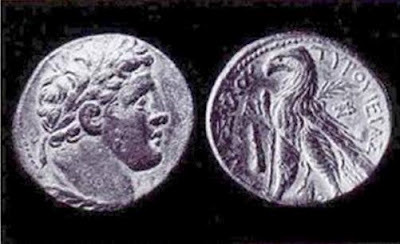 The Tyrian Shekel
The Tyrian Shekel
Hello My Friend and Welcome.
One of the largest hoards of ancient coins ever found was discovered in Israel in the spring of 1960 at a village called Isifa on Mount Carmel. The hoard consisted of 3,400 Tyrian Shekels, 1,000 Half-Shekels, and 160 Roman Denarii minted during Augustus’ reign. The bulk of the Shekels and Half-Shekels were dated from 20-53 AD.
At first glance this strange mix of coins at first seems to defy logic. At the time these coins were hidden, the Shekel was not in regular circulation. And both the Gospels and Josephus indicate that the coinage of that era was almost exclusively Roman. This means that the hoard could not have belonged to a private owner, or come from a bank or military strong box.
PAYING THE TEMPLE TAXIn the middle of the first century, the only use for Tyrian Shekels was payment of the prescribed Temple Tax. Every male Jew of 20 years of age and above had to pay a yearly tax of half a Shekel to support the Temple in Jerusalem. If we assume that the Mount Carmel hoard represents a shipment of taxes due the Temple, the question of its strange composition becomes clear.
Consider first that they were predominantly Tyrian Shekels which were of sufficient quality for Temple use. The Half-Shekels, however, were minted in Antioch by the Romans and were under weight. Therefore the Misnah stipulated that an agio, or small additional percentage, of 4-8% was required along with the Half-Shekel to bring it up to full value. In other words, if you paid for two people with a Tyrian Shekel, you were home free, but if you paid just for yourself with a Half-Shekel you had to add in the agio. This is proven by Matthew 17:24-28 in which Peter is told to catch a fish with a Shekel in its mouth…a sufficient tax for both himself and Jesus.
Interestingly enough, the 160 Denarii represents an agio of exactly 8% on the 1,000 Half-Shekels found in the hoard. The presence of the Augustinian Denarii is explained by the fact that the inflated Denarii of Nero were rejected by the Temple treasury. Only the full-weight Denarii of Augustus were considered acceptable payment.
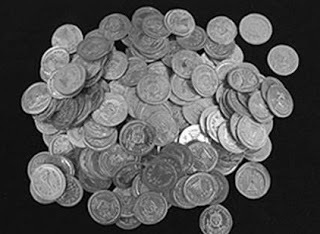
UNRAVELING THE RIDDLE If one assumes that the hoard represents a shipment of taxes destined for the Temple, the answer to not only where they came from, but also when it was concealed becomes clear. Fact One: The hoard represents the Temple-Dues of 7,800 male Jews of more than 20 years of age, or a community of approximately 30,000 Jews. Fact Two: According to the Mishnah, the Temple Tax for all of Palestinia was due at the Temple by the beginning of April. Egypt and Phoenicia were due in June, and Babylon, Mesopotamia and all other regions in September.
Based on this timetable, the entire Temple Tax could not have reached its destination before the outbreak of the Jewish-Roman War in the summer of 66 AD. Assume for a moment that the taxes from Galilee for the year 67 AD were delivered to the Temple in April as required. From the defeat of Cestius Gallus in November of 66 AD until the beginning of the operations of Vespasian the following May, the country was free of the Romans.
However the transport of the Temple Tax from Phoenicia, which was due in June, probably reached Jewish territory in late May of 67. By then, Western Galilee was already occupied by Vespasian and the main roads to Jerusalem through Megiddo and Samaria were barred by the Romans.
Now assume that the convoy transporting the Temple Tax decided to bypass Megiddo by going over Mount Carmel to Narbata and from there to Jerusalem. However they found this way closed by a Roman detachment under the command of Cerealis.
HOPING FOR A QUICK END TO THE WAR Continuing this supposition, we can assume that the couriers hoped that the new Roman army under Vespasian would be defeated like that of Cestius Gallus. The leaders of the convoy then decide to conceal the money until the way to Jerusalem opened up again. Since they were coming from Phoenicia, they chose the first acceptable spot they came to — the Jewish village nearest the border between Phoenicia and the Jewish territory, a spot known today as Isifa. They then selected a spot near the ancient synagogue there, concealed their treasure, and set about waiting for things to blow over.
However, their hopes were dashed when Jerusalem was conquered and the Temple destroyed. The hoard of coins on Mount Carmel remained buried until it was discovered in 1960. Now we know that fate of the coins, but we can never know the fate of the men who buried them/
Until next time, we wish you Peace And Blessings.
If you reached this post via a link, click the HOME tab above to see other recent posts and visit our archives.
 The Tyrian Shekel
The Tyrian ShekelHello My Friend and Welcome.
One of the largest hoards of ancient coins ever found was discovered in Israel in the spring of 1960 at a village called Isifa on Mount Carmel. The hoard consisted of 3,400 Tyrian Shekels, 1,000 Half-Shekels, and 160 Roman Denarii minted during Augustus’ reign. The bulk of the Shekels and Half-Shekels were dated from 20-53 AD.
At first glance this strange mix of coins at first seems to defy logic. At the time these coins were hidden, the Shekel was not in regular circulation. And both the Gospels and Josephus indicate that the coinage of that era was almost exclusively Roman. This means that the hoard could not have belonged to a private owner, or come from a bank or military strong box.
PAYING THE TEMPLE TAXIn the middle of the first century, the only use for Tyrian Shekels was payment of the prescribed Temple Tax. Every male Jew of 20 years of age and above had to pay a yearly tax of half a Shekel to support the Temple in Jerusalem. If we assume that the Mount Carmel hoard represents a shipment of taxes due the Temple, the question of its strange composition becomes clear.
Consider first that they were predominantly Tyrian Shekels which were of sufficient quality for Temple use. The Half-Shekels, however, were minted in Antioch by the Romans and were under weight. Therefore the Misnah stipulated that an agio, or small additional percentage, of 4-8% was required along with the Half-Shekel to bring it up to full value. In other words, if you paid for two people with a Tyrian Shekel, you were home free, but if you paid just for yourself with a Half-Shekel you had to add in the agio. This is proven by Matthew 17:24-28 in which Peter is told to catch a fish with a Shekel in its mouth…a sufficient tax for both himself and Jesus.
Interestingly enough, the 160 Denarii represents an agio of exactly 8% on the 1,000 Half-Shekels found in the hoard. The presence of the Augustinian Denarii is explained by the fact that the inflated Denarii of Nero were rejected by the Temple treasury. Only the full-weight Denarii of Augustus were considered acceptable payment.

UNRAVELING THE RIDDLE If one assumes that the hoard represents a shipment of taxes destined for the Temple, the answer to not only where they came from, but also when it was concealed becomes clear. Fact One: The hoard represents the Temple-Dues of 7,800 male Jews of more than 20 years of age, or a community of approximately 30,000 Jews. Fact Two: According to the Mishnah, the Temple Tax for all of Palestinia was due at the Temple by the beginning of April. Egypt and Phoenicia were due in June, and Babylon, Mesopotamia and all other regions in September.
Based on this timetable, the entire Temple Tax could not have reached its destination before the outbreak of the Jewish-Roman War in the summer of 66 AD. Assume for a moment that the taxes from Galilee for the year 67 AD were delivered to the Temple in April as required. From the defeat of Cestius Gallus in November of 66 AD until the beginning of the operations of Vespasian the following May, the country was free of the Romans.
However the transport of the Temple Tax from Phoenicia, which was due in June, probably reached Jewish territory in late May of 67. By then, Western Galilee was already occupied by Vespasian and the main roads to Jerusalem through Megiddo and Samaria were barred by the Romans.
Now assume that the convoy transporting the Temple Tax decided to bypass Megiddo by going over Mount Carmel to Narbata and from there to Jerusalem. However they found this way closed by a Roman detachment under the command of Cerealis.
HOPING FOR A QUICK END TO THE WAR Continuing this supposition, we can assume that the couriers hoped that the new Roman army under Vespasian would be defeated like that of Cestius Gallus. The leaders of the convoy then decide to conceal the money until the way to Jerusalem opened up again. Since they were coming from Phoenicia, they chose the first acceptable spot they came to — the Jewish village nearest the border between Phoenicia and the Jewish territory, a spot known today as Isifa. They then selected a spot near the ancient synagogue there, concealed their treasure, and set about waiting for things to blow over.
However, their hopes were dashed when Jerusalem was conquered and the Temple destroyed. The hoard of coins on Mount Carmel remained buried until it was discovered in 1960. Now we know that fate of the coins, but we can never know the fate of the men who buried them/
Until next time, we wish you Peace And Blessings.
If you reached this post via a link, click the HOME tab above to see other recent posts and visit our archives.
Published on June 20, 2012 01:00
June 18, 2012
EARLY CHRISTIAN SYMBOLS — THE IKTHUS, or FISH
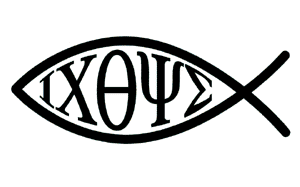
Hello My Friend and Welcome.
One of the earliest, and most common, symbols used by the Christians was the Ikthus, or Fish. We see used it today in its plainest form, two swooping lines, and in more elaborate forms with the inclusion of a small cross, the word JESUS, or the Greek ΙΧΘΥΣ within the classic fish shape. There’s more than one reason the Early Christians chose the symbol of a fish.
FISHERS OF MEN The use of the fish symbol reminds one of the familiar scene in Matthew 4:18-20, Mark 1:17 and Luke 5:2-11. In all of these passages, Jesus, who has returned from his 40 days of preparation in the desert, begins to gather his first disciples. While walking along the shores of the Sea of Galilee, or Lake Gennesaret as the Jews called it, Jesus encounters Simon and his brother, Andrew and invites them to become his followers with enigmatic phrase, “Follow me, and I will make you fishers of men.” Luke elaborates on the scene a bit and places the men in their boat after a night of luckless fishing. Jesus tells them to put down their nets for a catch, they do, and the nets fill to the point of bursting. True to form, Simon’s responds by saying, “Depart from me, for I am a sinful man, O Lord.”
THE ACROSTIC OF THE FISH An acrostic is a word or phrase in which each letter stands for a word. We’ve all heard the song that spells mother by starting with, “M is for many things she gave me…” Acrostics are closely related to acronyms, which are an abbreviation formed from the initial components of a word or phrase…for instance, OPEC (Organization of Petroleum Exporting Countries) NATO (North Atlantic Treaty Association), the dreaded FAQ (Frequently Asked Questions) and so on. There’s probably a vacation travel game lurking in our penchant for acronyms. It surely beats license plate bingo, but we digress.
The Greek word for fish is IKTHUS, spelled ΙΧΘΥΣ. Using those five letters, we can develop a phrase in the following way:With the Iota, we create the word Ιησονς…Iesous.
Using the next letter, Chi, yields the word Χριστος…Christos.
The Theta yields Θεος, Theos…God.
With the Tau, we make Υιος, Uihos…Son.
And the Sigma, gives us Σωτηρ, Soter…Savior.
As the song says, put them altogether and you get Iesous the Christos, God’s Son and our Savior.
A MEANS OF COMMUNICATION The simple image of the fish, or ikthus, became a means of identification for members of what the Romans considered a subversive cult. We find this simple symbol so rich in meaning scattered throughout the earliest examples of Christian art.
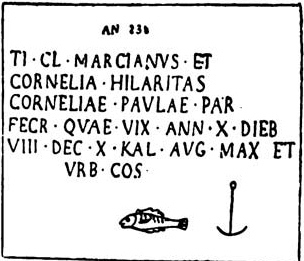 An Ancient Grave Carving Using the FISH
An Ancient Grave Carving Using the FISHNo one knows for sure who created it or when. However, the Acts of the Apostles tells us that it was in Antioch that the believers were first called Christians. Antioch was a thoroughly Greek city and former capitol of the Seleucid Empire. In the First Century it quickly became a leading center of the Early Church. It was the place from which Paul, Barnabas, John Mark, Silvanus and others left on their earliest missionary journeys. It was also the place to which they returned to rest, re-energize, and prepare for the next trip. This coupled with the fact that the fish relies upon a Greek spelling of the word to convey its message, tends to lead one to the assumption that it, like the word Christian, originated in or around Antioch of Syria. Think about that the next time you see the symbol on the back of someone’s car.
Until next time, we wish you Peace and Blessings.
If you reached this post via a link, click the HOME tab above to see other recent posts and visit our archives.
Published on June 18, 2012 01:00
June 15, 2012
FOODS OF THE FIRST CENTURY - WHAT THEY DIDN'T HAVE
 Sometimes You've Gotta Have a Bite of ChocolateHello My Friend and Welcome
Sometimes You've Gotta Have a Bite of ChocolateHello My Friend and WelcomeFor several months now we’ve looked at the various Foods of the Century…what they had and what they ate. Now we’re going to turn the tables and look at some of the foods they didn’t have.
THE BIBLE DIDN'T MEAN ITAs we’ve pointed out before, some translations of the Bible mention corn. Corn, or more properly, zea mays, is a new world grain and definitely not known to First Century inhabitants of the Levant. In the Middle Ages, the word corn was a catch-all term for grain. It could mean oats, rye, barley, wheat, etc. Consequently, when the Pilgrims came to the United States and encountered the crop zea mays — the Indians’ staple grain — they referred to it as corn. Which is why what Americans call corn is known everywhere else as maize.
ANOTHER STAPLE GRAIN MISSING
Although it has become a staple of Middle Eastern cooking, First Century residents also did not have rice. Its cultivation methods did not suit the semi-arid regions of the Levant. Rice is a native lowland crop of the Far East where it has traditionally been grown in flooded plains called paddies so its roots could make use of the nutrient content from the water. Paddy rice farmers usually plant the seeds first in small seedbeds and later transfer the plants into the flooded fields.
Now let’s participate in some internet telepathy. First we’ll give you a phrase, and then we’ll tell you the first thing that popped into your mind.
Okay, here we go. The phrase is Italian Restaurant.
The first thing that came to mind was pasta with a tomato- based red sauce. Perhaps it was spaghetti with marinara and freshly grated Parmesan, or maybe a steaming pan of lasagna. Neither of them? Well, how about farfelle, fettuccine, linguine, macaroni, manicotti, mostacolli, penne rigate, pierogi, ravioli,rigatoni…risotto? I’d be willing to bet dollars to donuts that 99 out of a hundred people equate Italian cooking with tomato sauce and pasta.

NEW WORLD VEGETABLESThe thing that makes this so interesting is that First Century Romans, the precursors of today’s Italians, had neither tomatoes nor noodles. They had all the ingredients for the noodles, but the technology never appeared until Marco Polo’s fabled trip to the Orient. And the tomatoes didn’t arrive until the Age of Exploration carried seafaring adventurers to the New World where, in addition to looting gold, silver and precious gems, they discovered such New World vegetables as squash in its myriad forms, potatoes, tomatoes, corn, and peanuts.
A STEAMING CUP OF TEAEarly Christians also didn’t have tea to drink, if by tea you mean the dried leaves of the tea bush. Legend says that one summer day Shen Nung, an early Chinese emperor, was visiting a distant province and ordered his servants to boil some water. Dried leaves from a nearby bush fell into the pot, turning the liquid brown. Intrigued, Shen Hung drank some and found it very refreshing. Tea drinking was restricted to the Orient until the 16thCentury when missionaries encountered it when they journeyed to the Far East.

What people in the time of Christ did have is what we call herbal tea today. If you check the ingredients on several packages of Celestial Seasonings herbal teas, you’ll find that they often utilize dried berries and fruit, aromatic leaves and various herbs and spices. All of which the First Century dweller had at their disposal and undoubtedly partook of.
One of the beverages I mention in my Seeds of Christianity Series is apple peel tea, made by steeping dried apple peels in hot water. In the interest of research I saved the peels the last time we canned apple sauce and dried them in our food dehydrator. I crushed the brittle peels, added them to boiling water, then strained and sweetened the resulting pink decoction. I found that it lacked pizzazz. However, the addition of some crushed cinnamon bark, dried berries and a pinch of allspice might perk it up quite a bit.
THEY WERE NOT CHOCOHOLICS
Now we come to the saddest, most heart-wrenching part of this post — the final two food items that the earliest Christians were forced to do without. I do not exaggerate when I say that more than a few people have sworn to me that they could NOT live without these two items. Perhaps those first Christians were a lot tougher than we give them credit for. The poor souls had no coffee and (shudder) no chocolate. They were aptly named. Anyone who can function without their morning cup of coffee surely must be a saint.
When my children were young and, as all children are prone to do, moaned about how deprived they were, I consoled them by telling them that the all ancient rulers and kings of this world never lived as good as they did. If the lack of coffee and chocolate doesn’t prove my case, nothing ever will.
Until next time, we wish you Peace and Blessings.
If you reached this post via a link, click the HOME tab above to see other recent posts and visit our archives.
Published on June 15, 2012 01:00
June 13, 2012
ALEXANDER THE GREAT'S LEGACY IN THE HOLY LAND
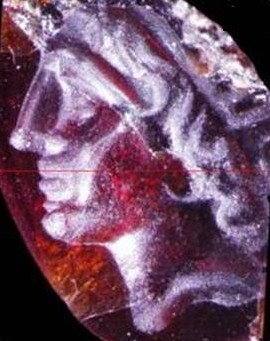
Hello My Friend and Welcome.
Today’s post concerns an archeological find at the Hellenistic port of Tel Dor, about 19 miles south of Haifa, Israel. Megan Webb, from Philadelphia, was digging in an area that had once held a large public building when her trowel unearthed a gemstone shown above with an etched portrait of Alexander the Great. It is a partial setting from a ring.
Dor was a major port city on the Mediterranean shore until the establishment of Caesarea by Herod the Great during the Roman period. Alexander the Great passed through Dor in 332 BC, following the occupation of Tyre, on his way to Egypt. It seems the city submitted to Alexander without resistance. Dor then remained a center of Hellenization in the land of Israel until it was conquered by Alexander Janneus, Hasmonean king of Judah, in 100 BC.
“Despite its miniature dimensions – the stone is less than a centimeter high and its width is less than half a centimeter – the engraver was able to depict the bust of Alexander on the gem without omitting any of the ruler's characteristics,” notes Dr. Gilboa, Chair of the Department of Archaeology at the University of Haifa. “The emperor is portrayed as young and forceful, with a strong chin, straight nose and long curly hair held in place by a diadem.”
The Tel Dor researchers have noted that it is surprising that such a work of art would be found in Israel, on the periphery of the Hellenistic world. “It is generally assumed that the master artists – such as the one who engraved the image of Alexander on this particular gemstone – were mainly employed by the leading courts in the capital cities, such as those in Alexandria in Egypt and Seleucia in Syria. This new discovery is evidence that local elites in secondary centers, such as Tel Dor, appreciated superior objects of art and could afford ownership of such items,” the researchers stated. One wonders who the ring in question belonged to.
Right about now you may be saying to yourself, “All this is quite interesting, but where does Alexander the Great fit in with Early Christianity?” Well, he doesn’t…and yet he sort of does. Let’s look at some of the facts. Alexander died in 323 BC, the same year he passed through Dor. Following his death the empire he’d just created was broken into pieces by his generals, the Diadochi (plural of Latin Diadochus, from Greek: Διάδοχοι, Diadokhoi, successors).
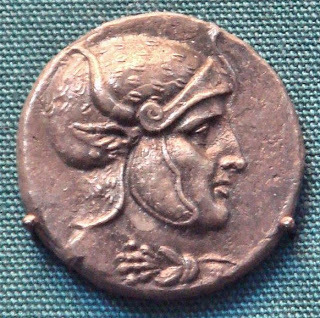 Coin Featuring Portrait of Seleucus I
Coin Featuring Portrait of Seleucus ITwo of the important Diadokhoi were Ptolemy I, founder of the Ptolemaic Dynasty in Egypt and progenitor of Cleopatra, and Seleucus I, founder of the Seleucid Dynasty which, at its peak, controlled over 1.2 million square miles from the Near East to Mesopotamia, Persia and today's Turkmenistan, Pamir and parts of Pakistan and India. Seleucus named multiple cities in his kingdom after his father Antiochus. He established two capitals. One was Seleucia on the Tigris River and the other was Antioch of Syria. A series of wars between later Ptolemaic and Seleucid rulers weakened both empires to such an extent that the Romans defeated the Ptolemy’s and Parthia eventually overthrew the Seleucids.
But before the Roman and Parthians came onto the scene, another interesting event occurred. Antiochus IV, Epiphanes, decided to destroy all worship of the one true God in Israel. To accomplish this end he slaughtered many thousands of tpeople. Women who had their babies circumcised were executed and their dead babies hung around their necks (I Maccabees 1:60-61). Antiochus believed that such visible acts of extreme cruelty would discourage the Jews from worshipping their God. However, he underestimated the enduring faith of the Israelites and this miscalculation cost him dearly. Not long after he defiled the Temple, the first stirrings of a revolt surfaced in an unexpected part of the empire, led by a relatively unknown Jewish family. It would grow into a bloody struggle for Jewish independence which has come to be known by several names…The Maccabean Revolt, The Hasmonean Period, or simply The Period of Independence.
It began in the little village of Modein, which was 17 miles NW of Jerusalem. An aged priest named Mattathias, lived there with his five sons: John, Simon, Judas, Eleazer, and Jonathan. Antiochus sent some of his officers to the village in 167 BC to force the Jews living there to offer sacrifices to the pagan gods. Mattathias, as a leader in the city, was commanded by the officers to be the first person to offer a sacrifice as an example to the rest of the people. He refused with a noble speech reminiscent of the words of Joshua in Joshua 24:14-15 (I Maccabees 2:15-22).
Fearing bloody reprisals against the people, a certain Jew stepped forward and volunteered to offer the sacrifices in the place of the priest. Mattathias, overcome with zeal to defend his God, killed the man as well as the officers of the king. He then tore down the altar to the pagan gods and ran through the village shouting, “Let everyone who is zealous for the Law and who stands by the covenant follow me!”
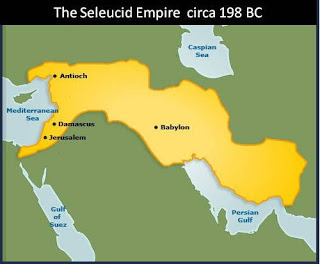
Matthias’ son, Judas, was possibly one of the greatest military minds in all of Jewish history. Even though greatly outnumbered, Judas and his rebels defeated general after general in battle. He overpowered General Appolonius near Samaria, routed General Seron in the valley of Beth-horan, and in a tremendous victory south of Mizpah, he conquered three generals and a combined army of 50,000 troops with only 6000 poorly equipped Jewish rebels. The people of Israel began to call him Judas Maccabeus (Judas the Hammer) because of his great daring and success in hammering the enemy forces into the ground.
Anyone wishing to read the complete story of their revolt can find it in I and II Maccabees in the Bible. The Hasmoneans ruled independently for the next 100 years. During this time they reasserted the Jewish religion, and expanded the boundaries and influence of Israel. In 63 BC the Roman general Pompey captured Jerusalem and Israel became a client state of Rome under the Hasmoneans. Their dynasty ended in 37 BC when Herod the Great, with Roman backing, overthrew the Hasmoneans and thus set the stage for the birth of Jesus of Nazareth and the subsequent rise of Christianity.
Until next time, we wish you Peace and Blessings.
If you reached this post via a link, click the HOME tab above to see other recent posts and visit our archives.
Published on June 13, 2012 01:00
June 11, 2012
PROMISES FREE FOR THE KINDLE
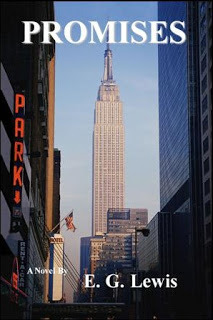
Hello My Friend and Welcome.
Free days for my commerical novel, PROMISES, are back by popular demand. You can download the Kindle version of PROMISES HERE all day Monday, June 11th, Tuesday, June 12th, and Wendnesday June13th.
SYNOPSIS.
Smooth as a sip of Kentucky Bourbon, PROMISES eases you into the Appalachian hill country. That wonderfully wild place of mountains and hollows, creeks and rivers, with its hardscrabble life and whiteboard churches where roots go deep, family matters, and Granny Wright is never wrong. A place where King Coal still rules, and beneath its veneer of respectability lays a hidden web of treachery. Mary Jane Combs may have gotten her Momma's good looks, but her strong-willed determination came straight from Daddy. Growing up in Kentucky she dreamed of a simple life with a loving husband, a home of her own, and healthy kids.
Instead she's become an international Supermodel, swapping the Appalachian coal country for New York City's Upper West Side and traveling the world in her private jet. Now she'll need all the determination she can muster when her ex-husband sets out to destroy everything she's accomplished. But two questions remain unanswered: Can she do what needs to be done and still remain true to the promises she made at her mother's deathbed? And when the dust settles, will she at last find the loving relationship she always dreamed of as a girl? REVIEWERS SAY:Part coming of age, part romance, and 100% fun reading, PROMISES is one of those unique novels that keeps getting better and better. After letting his readers settle into life in Appalachian Kentucky, Mr. Lewis catapults them and his strong female protagonist, off to New York, London, Paris, and beyond. But whatever the situation, she keeps her cool and responds with grace and courage forever destroying the myth of the dumb blond. —Brian Nolan for Northwest Book Review
PROMISES by E.G. Lewis was certainly not what I was expecting, and in this case that is a good thing! Rather than a fluffy romance, I got a well written novel with substance. It is the epic journey of a woman who rises above the trials of life to become the person she was meant to be all along. It starts when Mary Jane is just 15, on the eve of her mother’s funeral. From there it takes us through her struggles at home and at college, first love, more tragedy, success, fame, fortune, betrayal, revenge … pretty much the whole gamut of human emotion! At first glance, this list almost sounds trite, but Lewis’s writing is so provocative, so descriptive, so in tune with the human psyche, that this book is anything but cliché. He draws us into MJ’s world with such craft and precision that before you know it you just have to keep reading. I highly recommend it. —Tracy Krauss for Expression Express
In PROMISES, young girl endures hardship to become a highly successful super model traveling the world. Yet her fame and fortune are threatened when an unscrupulous entrepreneur tricks her into marriage. What follows is immensely satisfying. Although she endures humiliation and her career is damaged at his hands, she retaliates in a way only a strong, intelligent woman could.
The novel has a strong sense of place: Kentucky, New York, Paris and the Caribbean; lots of interesting information about the stock market and how public corporations function. Hard work and family loyalty help her overcome obstacles and succeed.
Despite the fact that she's neither a dumb blond, nor an easy lay, Claudia’s life is not without romance. This great story concludes with a wonderful feel good ending. I loved the characters and loved the story. It's a rewarding read. I adored Claudia Monet and HIGHLY RECOMMEND this novel to everyone. —Zara Heritage for Summit Book Reviews
Get your free copy of PROMISES for the Kindle by clicking HERE!
On Wednesday, we'll be looking at Alexander the Great in the Holy Land.
Until then, We wish you Peace and Blessings
Published on June 11, 2012 00:00
June 8, 2012
TABULA: A FIRST CENTURY GAME
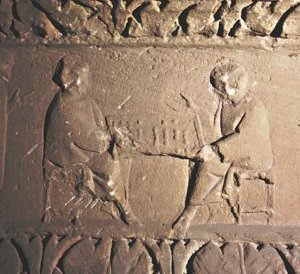 A Wall Carving of Tabula Players
A Wall Carving of Tabula Players
Hello My Friend and Welcome.
Today we return to our series on the Games People Played and take a look at the ancient Roman game of Tabula. The game dates back to several centuries BC and was originally known as Alea, meaning gambling. It eventually came to be called Tabula, meaning board or table, since it was played on a board or, more often than not, on a table which had been inscribed with the game’s outline.
THE DERIVATION OF TABULAAlea, or Tabula, seems to have been derived from the game Duodecim Scriptorum, known as the game of twelve lines. Duodecim Scriptorum, in turn, bears a striking similarity to the Egyptian game Senet, which can be dated to at least 3,000 BC. For more information see our earlier post on Duodecim Scriptorum.
SPREADING THROUGHOUT THE EMPIRE AND BEYONDTabula was particularly popular with the soldiers of Rome’s Legions. Going with them wherever they went, it was gradually spread throughout the Empire. Tabula moved into Persia, Asia Minor, Syria and Palestine with Pompey’s victories in the early First Century BC. Rome’s influence spread into Egypt, Arabia and North Africa following the defeat of Antony and Cleopatra by Octavian’s general, Agrippa, in the Battle of Actium in 31 BC.
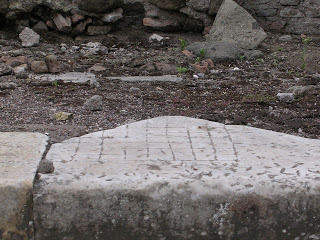 Ancient Playing Grid Etched into a Step
Ancient Playing Grid Etched into a Step
Tabula moved across Europe with the Roman Army, spawning a variety of games throughout the area. The games of Ad Elta Stelpur in Iceland, Taefle and Fayles in England, Sixe-Ace in Spain, and Tourne-casein France all trace their origin back to Tabula. The Arabian game Nard also appears to be a slightly modified version of Tabula combined with aspects of the Egyptian Senet.
Nard spread to the Far East, probably via spice and silk traders, in the early Third Century where it became extremely popular. Chinese tradition attributes the invention of Nard to western India. The considerable diversity of this genre of games, called race games, all of which incorporate a common mode of play. Because of this and the resulting sharing of ideas and innovations, it is sometimes impossible to trace the development of a specific game with absolute certainty.
The similarities between Tabula and modern Backgammon are readily apparent, just as the relationship between Duodecim Scriptorum and Tabula is easily recognized. The primary difference between the latter two is the expanded board of Tabula which allows the playing pieces to be set alongside each other rather than stacked. This change in the board’s dimensions may have been driven by practical necessity. The typical bone playing pieces were most probably unevenly cut and, therefore, not easy to stack.
A GAME OF HISTORICAL PROPORTIONSOur detailed knowledge of the rules of Tabula comes from the record of a game played by the emperor Zeno in the year 480. The position of the playing pieces is illustrated below. Zeno’s defeat was so sudden and unexpected that the details of the game were preserved for posterity. Zeno, playing white, threw a 2, 5 and 6 with the dice, forcing him to break up his three pairs. This left all of his men blocked. Since no other moves were possible, this single throw of dice constituted a game-ending move.
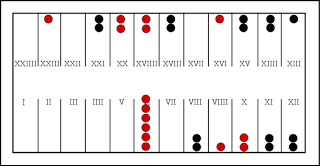
Tabula appears to have been the game of preference for many Emperors. Claudius was particularly fond of the game and, around the year 50AD wrote a history of the game. Though the event is recorded, the document itself has been lost to history. Claudius even had the imperial carriage outfitted with an alveus, or Tabula playing board, so that he could play while traveling. Exactly how Claudius managed to keep the game pieces from sliding around in a rocking carriage is never addressed. This was, after all, well before the introduction of magnetic game boards for use while traveling.
Tabula is primarily responsible for the gambling mania that swept Rome prior to its being declared illegal. During the time in which Rome was a Republic, open gambling was banned except during the winter Saturnalia Festival. Although the ban was weakly and sporadically enforced, gambling carried a fine of four times the stakes.
Tabula players used the same bone roundels used in board games such as Duodecim Scriptorum and Calculi. The colors seem to have been mostly black and white, or blue and white, but other colors have been found. At the high end of the scale, the very rich might use custom-made colored glass pieces instead.
THE RULES OF THE GAMEEach player has 15 playing pieces.
All pieces enter from square 1 and travel counterclockwise.
Three dice are thrown. The count of the dice can be applied to one, two, or three men, but the count on the faces of any of the dice cannot be split.
Any part of a throw which cannot be used is lost, but a player must use the whole value of the throw if possible. (Zeno's fatal situation resulted from this rule.)
If a player’s piece lands on a point with one enemy piece, the enemy piece is removed and must re-enter the game on the next throw.
If a player has 2 or more men on a point, that position is closed to the enemy and the men cannot be captured.
No player may enter the second half of the board until all men have entered the board.
No player may exit the board until all pieces have entered the last quarter. This means that if a single man is hit, the remaining pieces are frozen in the last quarter until that piece re-enters and catches up with them again.
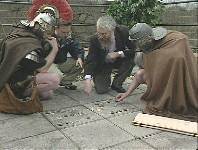 Re-enactors and Histroians with Tabula GameIf you would like to try a game of tabula, you can easily create the board with only a piece of posterboard, a ruler and pen. (Some people skip this step and use a backgammon board instead.) Checkers or poker chips make great game pieces.
Re-enactors and Histroians with Tabula GameIf you would like to try a game of tabula, you can easily create the board with only a piece of posterboard, a ruler and pen. (Some people skip this step and use a backgammon board instead.) Checkers or poker chips make great game pieces.
Until next time, we wish you Peace and Blessings
 A Wall Carving of Tabula Players
A Wall Carving of Tabula PlayersHello My Friend and Welcome.
Today we return to our series on the Games People Played and take a look at the ancient Roman game of Tabula. The game dates back to several centuries BC and was originally known as Alea, meaning gambling. It eventually came to be called Tabula, meaning board or table, since it was played on a board or, more often than not, on a table which had been inscribed with the game’s outline.
THE DERIVATION OF TABULAAlea, or Tabula, seems to have been derived from the game Duodecim Scriptorum, known as the game of twelve lines. Duodecim Scriptorum, in turn, bears a striking similarity to the Egyptian game Senet, which can be dated to at least 3,000 BC. For more information see our earlier post on Duodecim Scriptorum.
SPREADING THROUGHOUT THE EMPIRE AND BEYONDTabula was particularly popular with the soldiers of Rome’s Legions. Going with them wherever they went, it was gradually spread throughout the Empire. Tabula moved into Persia, Asia Minor, Syria and Palestine with Pompey’s victories in the early First Century BC. Rome’s influence spread into Egypt, Arabia and North Africa following the defeat of Antony and Cleopatra by Octavian’s general, Agrippa, in the Battle of Actium in 31 BC.
 Ancient Playing Grid Etched into a Step
Ancient Playing Grid Etched into a StepTabula moved across Europe with the Roman Army, spawning a variety of games throughout the area. The games of Ad Elta Stelpur in Iceland, Taefle and Fayles in England, Sixe-Ace in Spain, and Tourne-casein France all trace their origin back to Tabula. The Arabian game Nard also appears to be a slightly modified version of Tabula combined with aspects of the Egyptian Senet.
Nard spread to the Far East, probably via spice and silk traders, in the early Third Century where it became extremely popular. Chinese tradition attributes the invention of Nard to western India. The considerable diversity of this genre of games, called race games, all of which incorporate a common mode of play. Because of this and the resulting sharing of ideas and innovations, it is sometimes impossible to trace the development of a specific game with absolute certainty.
The similarities between Tabula and modern Backgammon are readily apparent, just as the relationship between Duodecim Scriptorum and Tabula is easily recognized. The primary difference between the latter two is the expanded board of Tabula which allows the playing pieces to be set alongside each other rather than stacked. This change in the board’s dimensions may have been driven by practical necessity. The typical bone playing pieces were most probably unevenly cut and, therefore, not easy to stack.
A GAME OF HISTORICAL PROPORTIONSOur detailed knowledge of the rules of Tabula comes from the record of a game played by the emperor Zeno in the year 480. The position of the playing pieces is illustrated below. Zeno’s defeat was so sudden and unexpected that the details of the game were preserved for posterity. Zeno, playing white, threw a 2, 5 and 6 with the dice, forcing him to break up his three pairs. This left all of his men blocked. Since no other moves were possible, this single throw of dice constituted a game-ending move.

Tabula appears to have been the game of preference for many Emperors. Claudius was particularly fond of the game and, around the year 50AD wrote a history of the game. Though the event is recorded, the document itself has been lost to history. Claudius even had the imperial carriage outfitted with an alveus, or Tabula playing board, so that he could play while traveling. Exactly how Claudius managed to keep the game pieces from sliding around in a rocking carriage is never addressed. This was, after all, well before the introduction of magnetic game boards for use while traveling.
Tabula is primarily responsible for the gambling mania that swept Rome prior to its being declared illegal. During the time in which Rome was a Republic, open gambling was banned except during the winter Saturnalia Festival. Although the ban was weakly and sporadically enforced, gambling carried a fine of four times the stakes.
Tabula players used the same bone roundels used in board games such as Duodecim Scriptorum and Calculi. The colors seem to have been mostly black and white, or blue and white, but other colors have been found. At the high end of the scale, the very rich might use custom-made colored glass pieces instead.
THE RULES OF THE GAMEEach player has 15 playing pieces.
All pieces enter from square 1 and travel counterclockwise.
Three dice are thrown. The count of the dice can be applied to one, two, or three men, but the count on the faces of any of the dice cannot be split.
Any part of a throw which cannot be used is lost, but a player must use the whole value of the throw if possible. (Zeno's fatal situation resulted from this rule.)
If a player’s piece lands on a point with one enemy piece, the enemy piece is removed and must re-enter the game on the next throw.
If a player has 2 or more men on a point, that position is closed to the enemy and the men cannot be captured.
No player may enter the second half of the board until all men have entered the board.
No player may exit the board until all pieces have entered the last quarter. This means that if a single man is hit, the remaining pieces are frozen in the last quarter until that piece re-enters and catches up with them again.
 Re-enactors and Histroians with Tabula GameIf you would like to try a game of tabula, you can easily create the board with only a piece of posterboard, a ruler and pen. (Some people skip this step and use a backgammon board instead.) Checkers or poker chips make great game pieces.
Re-enactors and Histroians with Tabula GameIf you would like to try a game of tabula, you can easily create the board with only a piece of posterboard, a ruler and pen. (Some people skip this step and use a backgammon board instead.) Checkers or poker chips make great game pieces.Until next time, we wish you Peace and Blessings
Published on June 08, 2012 01:00
June 6, 2012
PAUL, THE TENTMAKER FROM TARSUS
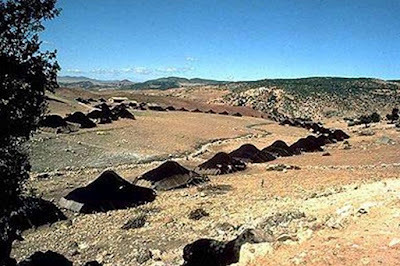 Rows of Black Tents Create a Nomadic Village in the Negev
Rows of Black Tents Create a Nomadic Village in the NegevHello My Friend and Welcome.
ANTIOCH AND PAUL the APOSTLE Saul, renamed Paul, spent a considerable amount of time working in the Church at Antioch. He also visited Antioch while on his missionary journeys. Sound contradictory? It isn’t. In those days, there were a number of greater and lesser Antiochs scattered about Asia Minor…all named in honor of Antiochus, father of Seleucus who founded the Seleucid Empire. Te most important of these was Antioch on the Orentes, the Western capitol of the Seleucid Empire, the seat of the Roman Province Syria and the third largest city in the Roman Empire, after Rome and Alexandria.
Christianity came to Antioch early. Believers began leaving Jerusalem following the persecution which resulted in Stephen’s death. The new faith was preached to and accepted by the Greeks of the city and it was in Antioch that the name Christian, or Christianos, originated. Antioch served as a base for the missionary journeys of Paul, Barnabus, Silas and others. The Church at Antioch played a preeminent role in the First and Second Century, especially after 70 AD when the Romans destroyed Jerusalem.
A TENTMAKER FROM TARSUS One of the things we know about Saul/Paul is that he was a Jewish tentmaker from Tarsus in Cilicia. Cilicia was part of the larger area known to the Romans as Asia Minor in what is now southern Turkey. Its western boundary was the Taurus mountain range, a generally inaccessible area. A mountain pass, known as the Cilician Gate provided a way through the mountains to Cappadocia. The eastern half of Cilicia consisted of broad, fertile plains. Tarsus lay a short distance inland from the Mediterranean Sea astride the road leading to the Cilician Gate. It probably saw a lot of traffic as trading caravans and other merchants transported goods between the port and Cappadocia.
PAUL IN ANTIOCHWe know from the epistles that Paul took great pride in being self-supporting. This would imply that he practiced his trade both at home and away. By home we, of course, mean Antioch, which was the closest thing Paul had to a permanent residence after his conversion to Christianity.
How much time did he actually spend there? Acts 11 tells us that after Barnabus returned from Tarsus with Paul, they spent a year in the city preaching and teaching. They then took famine relief to Jerusalem and returned with John Mark. There appears to be an unspecified period of time prior to their leaving on the first missionary journey.
Paul and Barnabus were gone two years. Then they returned and stayed in Antioch for between two and three years…autumn of 46 – 49 AD. Acts 14 They left for the Council of Jerusalem and, as soon as they got back, began preparing for the second missionary journey, which began about 50 AD. We know from Acts that Paul refused to all John Mark accompany them on the second mission. John Mark was Barnabas’s cousin, and this decision created a rift between the two men. Paul took Silvanus (Silas) instead and Barnabas and John Mark went to Cyrpus, which was Barnabas’ home.
Paul returned two years later for a period of R & R that lasted another year, and then set off on his third missionary journey. He never returned to Antioch. Instead, he sailed to the Judean capitol of Caesarea at the end of his third mission, was arrested in Jerusalem, and subsequently taken to Rome. Still, from the narrative above, we can easily credit Paul with between six and seven years in Antioch during which time he would have supported himself by making tents.
TENTMAKER, TENTMAKER, MAKE ME A TENT Tents of that era were quite different from the quick up/quick down Coleman variety with adjustable aluminum poles, zippered flap and windows, and sewn-in floor. The tents of Paul’s day had no floor. The sides consisted of curtains that hung to the ground. They could be rolled back to admit the breeze during the day and pulled down to completely enclose the tent at night.
 Close-up of the Finished Tent ClothNew tents were typically only made when a young groom and his bride set up housekeeping for themselves. The tents consisted of long strips of fabric about three feet wide. These strips were sewn together to make any and all sizes of tents. The tent was regularly inspected and worn or ripped sections were removed and a new one sewn in its place. The piece they removed could be cut down and used for a side curtain. If the family grew and more space was required, additional strips were added to make the tent deeper or wider as necessary. Isaiah referred to this practice when he wrote, “Enlarge the place of your tent, and let the curtains of your habitations be stretched out; hold not back, lengthen your cords and strengthen your stakes.” (Isaiah 54:2)
Close-up of the Finished Tent ClothNew tents were typically only made when a young groom and his bride set up housekeeping for themselves. The tents consisted of long strips of fabric about three feet wide. These strips were sewn together to make any and all sizes of tents. The tent was regularly inspected and worn or ripped sections were removed and a new one sewn in its place. The piece they removed could be cut down and used for a side curtain. If the family grew and more space was required, additional strips were added to make the tent deeper or wider as necessary. Isaiah referred to this practice when he wrote, “Enlarge the place of your tent, and let the curtains of your habitations be stretched out; hold not back, lengthen your cords and strengthen your stakes.” (Isaiah 54:2)These strips of tent cloth were woven on a simple horizontal loom. Some of these looms required the weaver to sit or kneel on the floor as they worked. Since Paul spent long hours at the loom, he most probably used a model that provided a seat. The illustration below shows a man in Senegal using a loom similar to one that Paul most likely used. The frame is set up at the proper width of the fabric. A roller near the user’s knees accumulates the finished fabric. The incoming threads are secured to a roller far in front of the loom.

A double harness loom is most efficient when weaving a single colored fabric. Weaving consists of passing a single weft thread back and forth between multiple warp threads. The warp threads are long and close, forming the body of the fabric. Their overall width determines the width of the finished piece and the finished piece can be no longer that the warp threads. The weft thread is wound on a spool, known as a shuttle. It binds the opposing warp threads together as it is passed back and forth. In order to weave, individual warp threads must be separated (lifted) from their neighbors. Odd numbered threads are attached to one harness and even to the other. When one pedal is depressed, half of the threads rise allowing the shuttle to pass between the threads. When the other is depressed, the opposite threads rise for the shuttle’s return pass.
USING BLACK GOATS The tent fabric was woven from black goat hair. This resulting fabric was coarse and heavy, providing protection during the cold months and at night. The goat hair cloth used for tents remained porous when dry. This facilitated airflow and dissipated heat in a desert-like environment. During periods of higher moisture —heavy dew or winter rains— the thread quickly swelled, making the tent waterproof. Solomon referenced the color of the tents when he wrote, “I am very dark, but comely, O daughters of Jerusalem, like the tents of Kedar…” (Song of Solomon 1:5)
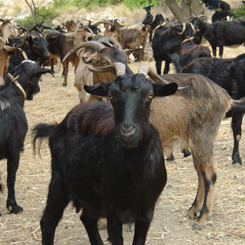
Antioch lay between the road running from Boerea, known as the Silk Road, to the port of Pieria Seleucia. Caravans from as far away as China and India must have passed through the city on a regular basis. These merchants all lived in tents while on the move. Antioch was surely as good a location for a tentmaker as he could hope to find.
Next time we’ll be examining the First Century game the Romans called Tabula.
Until then, we wish you Peace and Blessings.
If you reached this post via a link, click the HOME tab above to see other recent posts and visit our archives.
Published on June 06, 2012 01:00



